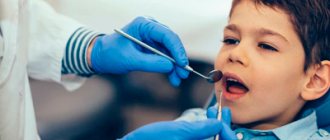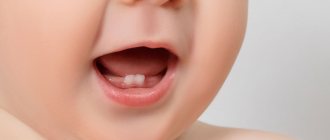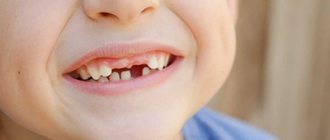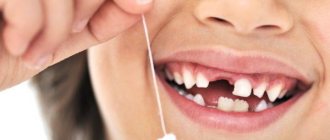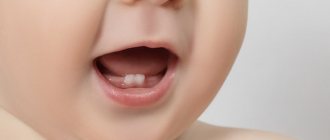Anatomy of permanent teeth
Each molar consists of certain parts:
- crown. This is the part of the tooth that protrudes from the top;
- the root, it goes deep into the alveoli. At the same time, it is attached thanks to special connective tissue bundles. There can be different numbers of roots (1-5 pieces). This moment affects the number of nerves and channels;
- neck. This part is located between the root and the crown.
Tooth tissues are distinguished by their heterogeneity. The enamel is on top and is known for its durability. Once the tooth has erupted, it is covered with a transparent thin layer. This is the cuticle, which eventually changes to the pellicle. The latter is a film that is created from what saliva produces.
Beneath the enamel is dentin, the tissue of the tooth. Dentin is similar to bone when you study how it is built. However, it is more durable because there is a high level of mineralization. In the area where the root is located, the dental tissue is covered with cement. The latter is rich in mineral compounds and is also associated with periodontium. Collagen fibers are used for this.
As for the part of the tooth that is inside, this is the crown and root canal. They are filled with pulp. This is loose connective tissue; it contains nerve endings and blood vessels.
Differences between baby teeth and permanent teeth
Permanent and temporary teeth are built in the same way, but still have certain differences between themselves:
- The enamel on baby teeth is whiter. And the enamel on permanent teeth has a yellowish tint;
- the best indicators of density and mineralization are noted behind the molars;
- the pulp of a baby tooth is large in size, and the dense tissues and their walls are thinner;
- permanent teeth are larger in size, here the length is greater than the width;
- The root of baby teeth is short and thin compared to permanent teeth. When the root of temporary teeth is formed, they expand in width. Therefore, the permanent bud has free space to grow.
What can cause delays in teething?
Reasons for deviation from normal timing:
- heredity;
- smoking or drinking alcohol by the mother during pregnancy;
- illnesses of the mother suffered during pregnancy or the presence of chronic diseases in one or both parents;
- toxicosis;
- prematurity or postmaturity of the baby (birth earlier or later);
- congenital hypothyroidism;
- rickets;
- diseases suffered by a newborn in the first months of life.
Interesting facts: according to statistics, first-born children develop teeth earlier than subsequent children; in babies from late-bearing mothers - earlier than in babies from young parents; for boys - later than for girls.
Where do teeth come from?
Teeth begin to form and develop when the fetus is still inside the womb (at about 6 weeks). They have their source - the epithelial dental plate. Already by 14 weeks, active formation of dental tissues, which are hard, occurs. Initially, this occurs in the area where the crown will be, and later at the root.
Molars, namely their first rudiments, appear by the 5th month of the embryo. They are located higher than the child’s baby teeth or lower. By the time the child is born, the rudiments are already practically formed in the tissues of the jaw.
Teeth that belong to an additional group (have no predecessors) are formed later. This occurs after about 1 year of life. Why? Because the baby's jaw is still very small and there is not enough space for them.
Development of teeth before eruption
The health of your baby’s teeth needs to be taken care of long before they erupt. It is useful for expectant mothers to know that the rudiments of baby teeth are formed already at the 7-8th week of intrauterine development, and permanent ones - at the end of 4 months. Not only the timing of teething, but even the level of mineralization of the enamel of both milk and molars depends on how pregnancy proceeds. Therefore, it is so critical that a woman receives all the vitamins and microelements and is as healthy as possible.
But it’s not just nutrition that’s important. Research results have shown that in the presence of industrial harmful substances in the environment of the expectant mother during pregnancy and numerous stressful situations, the formation of all dental tissues in the child is disrupted and the timing of the appearance of baby teeth is shifted. Among children born to women with high blood pressure, late eruption of primary teeth was observed in 56.7%. In approximately a third of the examined children born to mothers with heart defects, late eruption of primary teeth was detected, as well as deviations in the pairing and sequence of their eruption. The length of pregnancy also plays a role. There is a pronounced dependence of the timing of the eruption of the first teeth on the degree of prematurity: the earlier the baby is born, the later the first teeth erupt [1, 2].
What does a dental formula look like?
To make it more convenient to describe teeth and their number, special formulas are usually used. Each tooth has its own number, which is used to decipher its location.
When describing a milk bite, Roman numerals are used:
- incisors – I, II;
- canine – III;
- molars – IV, V.
If we talk about the formula for adult teeth, here the teeth are counted starting from the center:
- incisors – 1.2;
- fang – 3;
- molars (small) – 4.5;
- molars (large) – 6,7,8.
8 is a wisdom tooth; not every person has it.
Teething order
Typically, all children start teething at about the same time. Teeth emerge from the molar set at the age of 5, and it is the molars (large ones) that emerge. Then the diagram is as follows:
- Initially, the incisors on the lower jaw change, which are located in the center;
- then the central incisors appear on the upper jaw and the incisors on the sides on the lower jaw;
- at about 8-9 years old, the incisors on the top and sides change;
- up to 12 years of age, molars (small) grow;
- at the age of 13, the fangs change;
- after the child turns 14 years old, the second molars (large ones) come in. They were not included in the milk kit;
- and after another 1 year the third molars (large) appear. This is a wisdom tooth. But he may not appear at all.
Teething
According to the tradition of many peoples of the world, there is a custom of giving gifts to a child on the occasion of the appearance of the first tooth. This ritual symbolizes wishes to the baby for health, happiness and long life. The appearance of a baby’s first tooth is a solemn moment for relatives and parents, but at the same time, teething can also be a “restless” period for parents and the baby. I would like to reassure parents and orient them to the fact that teething is a physiological process and must be approached philosophically. As if it were inevitable. And timely and correct teething is a guarantee of a healthy future child.
What is teething?
Teething is the process of vertical movement of a tooth from its origin and development within the jaw until a crown appears in the oral cavity. The process of teething begins after the crown has finally formed and is accompanied by its further development and growth of the jaw bones. Signs of physiological teething are: timeliness, sequence of eruption of certain groups of teeth and pairing.
There are temporary teeth (more often called milk teeth) and permanent teeth. According to the number of teeth, the primary teeth are 20, the permanent bite is 32 teeth. According to modern data, the period for the eruption of the first temporary teeth is usually considered to be from 4 months. The end of eruption is 3-3.5 years. Most often, the first teeth appear at the age of 6 months, and as a rule, the teeth on the lower jaw erupt first - the central incisors, then the lateral incisors, canines and molars. The timing of teething can vary from 4 months to 2 years (early teething) or from 8-10 months to 3.5-4 years (late teething).
Average time for eruption of primary teeth according to (R. Illingworth, 1997)
| tooth | Timing of eruption (month of life) | |
| Lower jaw | Upper jaw | |
| Central incisor | 6 | 7,5 |
| Side cutter | 7 | 9 |
| First molar (chewing group of teeth) | 12 | 14 |
| Fang | 16 | 18 |
| Second molar (chewing group of teeth) | 20 | 24 |
It should be noted that the quality of nutrition, sanitary and hygienic conditions and pathological conditions of the child (rickets, hypovitaminosis, intoxication, states of oxygen starvation, the nature of feeding, etc.) significantly affect the process of teething. For example, disordered teething with disruption of the time intervals between groups of teeth, delayed eruption may be a manifestation of a pathology such as rickets.
Adverse effects during teething
Temporary teeth are not permanent, that’s why they are called that. As the child grows and develops, after a certain period of time, all 20 primary teeth will be replaced. As an exception, in individuals, milk teeth do not change, remaining in adulthood (most often this occurs due to the absence of the rudiments of permanent teeth).
When primary teeth erupt, the child is in a state of “stress” and can often manifest itself with general somatic disorders. The first signs of teething, often the main ones, are the appearance of swelling of the mucous membrane of the gums in the projection of the erupting teeth. Profuse salivation appears, the child may be irritated and tearful. The eruption of central teeth often occurs without any manifestations, except for swelling of the gums and profuse drooling. When the chewing group of teeth erupts and a larger area of the gum mucosa is involved, a secondary infection may occur if the resistance of the child’s body decreases. Symptoms such as increased body temperature, upset bowel movements, redness of the mucous membrane of the gums in the mouth, decreased appetite may appear. To relieve the annoying itch, the child begins to “drag” fingers and various objects into the mouth (toys, sucking the edge of clothing, a blanket) to scratch gums, thereby can damage and infect the mucous membrane. Which can manifest itself as erosive rashes. And aggravate this condition.
How can you help your child when they are teething?
To relieve itching of the gums in a child, it can be recommended to give hard vegetables or fruits (peeled apples, carrots), or a crust of bread to chew. It is good to massage the gums with special “teether” rings or a toothbrush (silicone, or a regular baby brush with soft bristles). Some rings can be pre-cooled, but you should carefully inspect these devices and purchase them in special places in order to avoid counterfeit, uncertified goods and subsequently not harm the baby’s health, so that the child does not get hurt. If the temperature rises, antipyretic drugs can be given. To reduce the sensitivity of the mucous membrane and reduce pain in pharmacies, pharmaceutical manufacturers offer special anesthetic gels for topical use. But we recommend using these drugs only as prescribed by a doctor, so as not to cause allergies in the baby and not miss more severe complications. Contact a pediatric dentist who will conduct an examination and give qualified prescriptions to improve your well-being.
Changing temporary teeth
Permanent teeth most often appear between 5.5 and 7 years of age. Their eruption practically occurs in the same sequence as temporary teeth. The lower central incisors appear first, then the upper central incisors, and in parallel, and sometimes earlier, the first large molars erupt (the first molars, or by their number, they are called “sixths”). Please note: The sixth teeth do not fall out! They should serve your child for life. Parents mistake them for temporary teeth, which is a misconception, especially in the case of absence or poor oral hygiene and damage to this group of teeth. Which can lead to a disastrous result – tooth loss. But this group of teeth - the “First molars” - are fundamental in the formation of a correct bite; they are also called the key of occlusion. The shape of permanent “young” teeth differs from more mature ones. The cusps and cutting edges of the crowns are more pronounced, especially the cutting edges of the central teeth have a scalloped (wavy edge), the size of a permanent tooth differs from a temporary tooth, it is larger. Some parents are alarmed by this fact. To which we answer, there is no reason to worry, literally a year after eruption, the enamel edge will become even and even. And regarding the size of the crowns of the teeth, while the child is small (the appearance of the first permanent teeth is 5.5-6 years old) relative to the facial skeleton, there is a certain disproportion; as the bones of the facial region grow and develop, a harmonious relationship between the face and teeth occurs.
Average time for the eruption of permanent teeth in children (according to Schroder, 1991)
| tooth | Timing of eruption (child's year of life) | |
| Lower jaw | Upper jaw | |
| Central incisor | 6-7 | 7-8 |
| Side cutter | 7-8 | 8-9 |
| Fang | 10-12 | 11-13 |
| First premolar (small molar) | 10-11 | 9-10 |
| Second premolar (small molar) | 11-12 | 10-11 |
| First molar | 5-6 | 6-7 |
| Second molar | 12-13 | 12-14 |
| Third molar (wisdom tooth) | 15 and older | 15-16 and older |
1. In order for the teeth to last a long time and not have to “say goodbye” before the appointed time, they need careful care when they erupt.
2. Go ahead for a consultation with a pediatric dentist, who will select age-appropriate hygiene products (toothbrush and toothpaste) for your child. He will provide training in teeth brushing techniques.
3. Brush your child’s teeth at least 2 times a day (in the morning after breakfast and in the evening before bed). Helping clean hard-to-reach areas from an early age
4. Limit your child’s consumption of carbohydrate-containing foods (we do not recommend eating sweets for children under 3 years old)
5. If a child drinks liquid drinks before bed or at night, they must be replaced with regular drinking water, without added sugars.
6. The use of toothpastes containing fluoride is very important for children of the Khanty-Mansiysk Autonomous Okrug-Ugra
7. Visit the dentist 2 times a year!!!
The article was prepared by: pediatric dentist Malakhova A.A. Head of TOD - Mokrinskaya N.G.
Photos used in the article from satyov:
1. https://ladyspecial.ru
2. https://otvetymamam.ru
How to determine that a child will soon have molars?
There are certain signs that indicate that permanent teeth will soon begin to erupt:
- The spaces between the teeth increase. The jaw grows and the free space increases;
- baby teeth become loose as the root gradually dissolves. It cannot be firmly fixed in the jaw tissues;
- in case of loss of a temporary tooth. This confirms that the molar will soon come out as it has pushed out the previous one;
- The gums are slightly swollen and red.
When permanent teeth erupt, the child’s general well-being usually remains the same, the temperature does not rise, and there is no pain.
Helping your baby with teething
The appearance of baby teeth is not an easy process not only for the children themselves, but also for their parents. The most common symptoms of teething:
- swelling and redness of the gums;
- increased salivation;
- itching and desire to keep hands and toys in the mouth;
- child's capriciousness;
- sleep disturbance;
- refusal to breastfeed, bottle or complementary foods;
- temperature increase;
- bowel disorders;
- runny nose.
The following will help you get through this period as comfortably as possible:
- special teething rings that relieve itching, especially with a cooling effect;
- dental gels with local anesthetic effect;
- antipyretic and painkillers;
light massage with a silicone fingertip, which will bring relief and calm the baby [6]
Possible problems
Permanent teeth have just appeared, but this does not mean that there will not immediately be any problems associated with them. Parents should be aware of possible dental problems:
- lack of molars;
- pain in the molar area;
- crooked position of molars;
- molars fall out;
- injuries.
For any of these problems, it is important to contact a specialist in time to receive qualified help.
Symptoms
Usually, no serious problems arise during teething, but local (in rare cases systemic) disturbances are present. These include:
- swelling and soreness of the gums;
- profuse drooling;
- irritability;
- restless sleep;
- lethargy;
- the baby's need for biting and chewing;
- poor appetite.
Loose stools, low-grade fever and runny nose are less common than the above symptoms.
Important! If the body temperature rises above 38 degrees, convulsions, difficulty breathing, you need to show the baby to a doctor and call an ambulance. This may indicate a viral infectious disease and is not a sign of teething.
Some parents wonder why this process occurs differently in babies. For example, in some teething occurs with fever, in others it does not. It is noted that, among other factors, this is also influenced by the child’s constitutional type. In children of the allergic type, this period may be accompanied by increased moodiness, atopic dermatitis, and ARVI is often associated. Infants with asthenic syndrome sleep poorly, refuse to eat, and cry for a long time due to severe pain.

